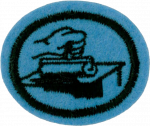Especialidades JA/Tipografía xilográfica
| Tipografía Xilográfica | ||
|---|---|---|
| Asociación General
|
Destreza: 2 Año de introducción: 1945 |
|
Requisitos
1. Enlistar las herramientas y equipos necesarios para la impresión.
2. Escribir un párrafo sobre los principios de diseño y letras tal como se aplica para la impresión xilográfica.
3. Using a potato, carve a design incorporating your initials into it, and use it to print your initials on paper.
Remember to reverse the letters and to put your first initial on the right side of the potato, and your last initial on the left.
4. Design and print at least one greeting card.
For this, we highly recommend that you use linoleum for the printing block. As you should well know from your experience with the previous requirement, potato printing leaves a lot to be desired.
Once you have chosen a design, follow these steps:
- Sand your piece of linoleum until it is smooth. Start with coarse grade sand paper (80 grit), follow that with finer grade (100 grit), and finally, use an even finer grade paper (120 grit).
- Draw your design on a piece of paper, and then transfer it to the piece of linoleum. If you draw the design in pencil, you may be able to transfer it by placing it face-down on the linoleum, and then tracing over the back, being sure to use plenty of pressure and covering every line, stroke, and dot. You can also draw your design directly onto the linoleum, but you must remember to draw it in reverse!
- Now you are ready to begin carving. Use a set of carving gouges for this, and always cut away from your hands and fingers. Do not cut too deeply. Remove all the negative space from the design, and be careful to leave the positive space intact. Once you cut it - it is gone.
- Once the linoleum has been carved, pour a small amount of ink onto the piece of glass. Then roll the brayer over the ink. Be sure to roll it in only one direction, not back and forth. If you roll it back and forth, you will not move the ink around. Instead, roll it forward, pick it up, pull it back towards yourself, and roll it forward again.
- Coat the linoleum with a thin layer of ink. Then coat it again. Several thin coats are better than one thick, gloppy coat.
- Place your blank greeting card (don't fold it until after it has been printed!) face up on your work surface. Then carefully place the inked surface of the block on it without moving it from side-to-side. Apply even pressure using the brayer, rolling pin, or the back of a wooden spoon. Be careful not to move the linoleum with respect to the paper at this point!
- Carefully lift the block from the paper and admire your results (or try again).
5. Design and print one bookplate or book cover.
Follow the procedure outlined in the previous requirement. A bookplate is a small piece of paper that is glued to the inside cover of a book to identify the owner. This obviously will require you to print some text, as that's the only way most of us write our names. A book cover should have the book's title as well as the author's name. It should be large enough to cover the outside of the book.
6. Going through the steps of designing, carving, and printing, create another original piece of work of your choice.
This could be a poster, another greeting card, another bookplate, another book cover, or whatever you would like to make. Repeating a carved pattern, while rotating it and/or changing the color can can create art work worth framing.
This requirement should be saved for last - it's your masterpiece!
References
- Wikipedia articles
- How to resources
- Categoría: Tiene imagen de insignia
- Adventist Youth Honors Answer Book/Honors/es
- Adventist Youth Honors Answer Book/es
- Adventist Youth Honors Answer Book/Skill Level 2/es
- Categoría: Libro de respuestas de especialidades JA/Especialidades introducidas en 1945
- Adventist Youth Honors Answer Book/General Conference/es
- Adventist Youth Honors Answer Book/Unknown/es
- Adventist Youth Honors Answer Book/Unknown/Primary/es
- Adventist Youth Honors Answer Book/Stage 100/es
- Adventist Youth Honors Answer Book/Completed Honors

